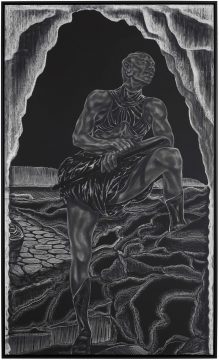Zadie Smith at The New Yorker:
 A woman stands in an otherworldly landscape, looking out. The landscape is sublime, though not the European sublime of cliffs, peaks, and mist. Here the sublime is African. It has many textures—conglomerations of stone, waterfalls, verdant grasslands—and may remind Nigerians of their own Jos Plateau. The woman stands with her left leg raised, surveying it all, with no sense of urgency; indeed, she appears to be in a state of philosophical contemplation. She seems assured both of her mastery over this land and of her natural right to it. This sovereignty is expressed primarily by her body—the fabrics she wears, the pose she strikes, all of which find their reflection in the land around her. The same dark lines tracing her impressive musculature render the rippling rocks; the ridges of her bald head match the ridges in the stone; the luxurious folds of the fabric are answered by the intricate layering of the earth beneath her feet. Toyin Ojih Odutola’s “The Ruling Class (Eshu)” appears, at first glance, to be a portrait of dominion. For to rule is to believe the land is made in your image, and, moreover, that everyone within it submits to you. Structurally, it recalls Caspar David Friedrich’s depiction of Enlightenment dominion, “Wanderer Above the Sea of Fog”: the same raised left leg, the same contemplation of power in tranquillity, the echoes of hair, pose, and fabric in the textured landscape. But the red-headed man with the cane and his back to us has been replaced by a black woman with a staff, facing forward. The script has been flipped.
A woman stands in an otherworldly landscape, looking out. The landscape is sublime, though not the European sublime of cliffs, peaks, and mist. Here the sublime is African. It has many textures—conglomerations of stone, waterfalls, verdant grasslands—and may remind Nigerians of their own Jos Plateau. The woman stands with her left leg raised, surveying it all, with no sense of urgency; indeed, she appears to be in a state of philosophical contemplation. She seems assured both of her mastery over this land and of her natural right to it. This sovereignty is expressed primarily by her body—the fabrics she wears, the pose she strikes, all of which find their reflection in the land around her. The same dark lines tracing her impressive musculature render the rippling rocks; the ridges of her bald head match the ridges in the stone; the luxurious folds of the fabric are answered by the intricate layering of the earth beneath her feet. Toyin Ojih Odutola’s “The Ruling Class (Eshu)” appears, at first glance, to be a portrait of dominion. For to rule is to believe the land is made in your image, and, moreover, that everyone within it submits to you. Structurally, it recalls Caspar David Friedrich’s depiction of Enlightenment dominion, “Wanderer Above the Sea of Fog”: the same raised left leg, the same contemplation of power in tranquillity, the echoes of hair, pose, and fabric in the textured landscape. But the red-headed man with the cane and his back to us has been replaced by a black woman with a staff, facing forward. The script has been flipped.
more here.
